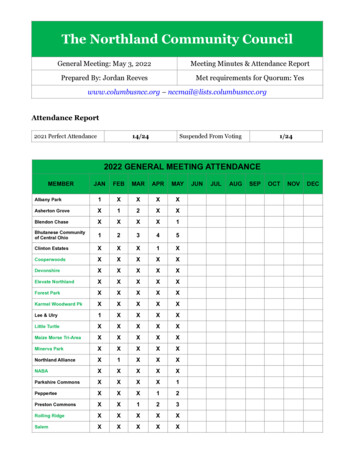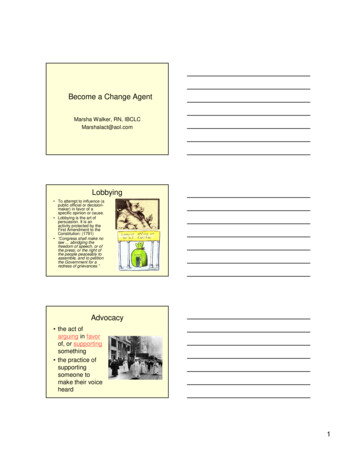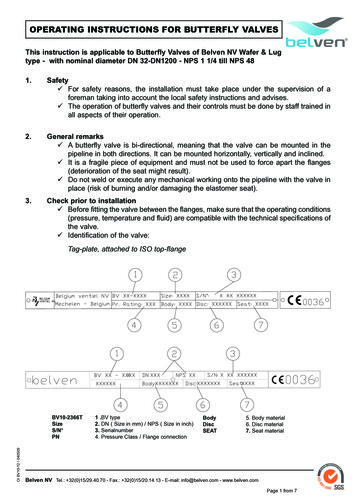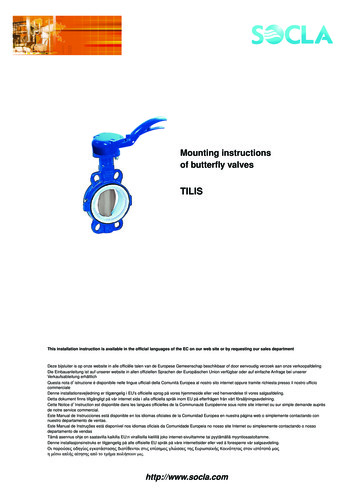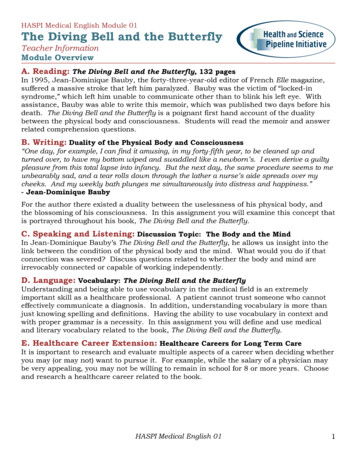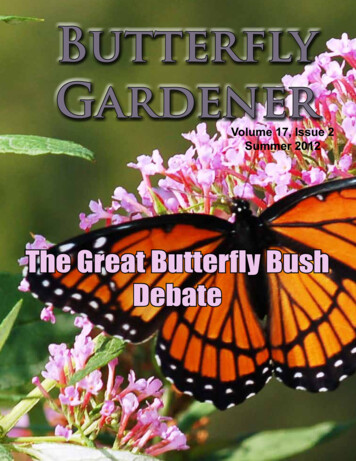
Transcription
ButterflyGardenerVolume 17, Issue 2Summer 2012The Great Butterfly BushDebate
Butterfly Gardener magazine is a publication of North American Butterfly Association (NABA). Membersof NABA receive both Butterfly Gardener and American Butterflies magazines. To become a member ofNABA, please see page 12 of this issue of Butterfly Gardener or visit www.naba.orgIn the five years since its inception, NABA’s Butterfly Garden Certification program has attracted over900 people interested in increasing habitat for butterflies. Many individuals, facilities, and institutions,including schools, golf courses, nursing homes, state parks, garden clubs, and cemeteries, have certified their habitats through NABA. Posting a NABA butterfly garden certification sign helps to open conversations about the importance of butterfly habitat and increase public awareness about the needs ofbutterflies.Have you certified your butterfly garden with NABA? If so, Butterfly Gardener might be interested inhighlighting your butterfly garden experience in the magazine. Submissions to the magazine should be1,000 words or less and be accompanied by three to five photos (of at least 1Mb file size). Gardens willbe selected on a variety of criteria such as quality of photos, location of garden (we would like to highlight many regions), types of plants used, and, of course, the story of your butterfly garden experience.Butterfly Gardener does not pay for articles but does provide three complimentary copies of the issuein which an author’s article runs. Additionally, certified butterfly gardens that are highlighted will receivea pdf of their Butterfly Gardener article that they may reproduce for their own use.For further details, please contact Butterfly Gardener at hurwitz@naba.orgCertify Your Love of Butterfly Gardening withNABA’s Butterfly Garden & Habitat ProgramVisit www.nababutterfly.comThis garden providesresources that increasethe world’s populationof butterfliesCertified Butterfly GardenNorth American Butterfly Association www.naba.orgeditor's notesThe Great Butterfly Bush Debate has long beenraging. It seems everything about this plant - Buddlejadavidii - is debatable, from the spelling of its scientificname (is it Buddleja as indicated on the USDAwebsite, or the more commonly used Buddleia?)to the plant’s common name (is it Orange EyeButterflybush, courtesy again of the USDA website, orthe more widely used butterfly bush?).Butterfly Gardener is publishedquarterly by the North AmericanButterfly Association, Inc. (NABA). 2012 by the North AmericanButterfly Association, Inc. All rightsreserved. Views of contributors donot necessarily reflect the views ofNABA.When we move from the name of the plant to the useof the plant, the debate intensifies. What role should itplay in butterfly gardening? Is it too invasive? Shouldit be planted at all?We want to hear from you!Please send Butterfly Gardenercorrespondence and submissions to:Jane Hurwitz, Editor, NABA,4 Delaware Road, Morristown, NJ07960; hurwitz@naba.orgThis special issue of Butterfly Gardener is devoted tothe butterfly bush (however you choose to name orspell it). The sole purpose of the issue is to providelots of food for thought, similar to the overload ofnectar provided by the butterfly bush itself. My ownthoughts about using butterfly bush as a nectar planthave changed quite a bit as a result of this issue.Perhaps yours will too.Many wonderful writers have helped shape and writethis special issue. From inception, they have providedfeedback, suggestions, and, of course, their writing: Mary Anne Borge and Lenora Larson steppedforward to provide contrasting articles aboutthe use of this popular nectar plant, agreeing todisagree. Charlotte Adelman wrote an overview of nativebutterfly bushes that might be used in thesouthwestern portions of the United States. Instars contributor Sal Levinson developed anectar garden paper craft to compliment theissue’s theme. And many NABA members answered an onlinesurvey adding their own experiences and ideas tothe great butterfly bush debate!- Jane Hurwitz, EditorButterfly Gardener www.naba.org2Summer 2012Butterfly Gardener www.naba.org3Articles, gardening tips andobservations, artwork, digital highresolution photographs, poetry andcomments will be considered forpublication. Please sendself-addressed stamped envelope foritems to be returned.AdvertisingButterfly Gardener welcomesadvertising. Please write us at:Butterfly Gardener, 4 DelawareRoad, Morristown, NJ 07960, ortelephone (973) 285-0907 or fax(973) 285-0936 for current rates andclosing dates.Membership ServicesFor questions concerningmembership issues, magazines, orchanges of address, please write toNABA Membership Services,4 Delaware Road, Morristown, NJ07960. Occasionally, members sendmembership dues in twice. Ourpolicy in such cases, unlessinstructed otherwise, is to extendmembership for an additional year.Summer 2012
NABA is a not-for-profit organization formed to educate the public about the joys of nonconsumptive, recreational butterflying including listing, gardening, observation, photography,rearing, and conservation. Membership in NABA is open to all who share our purpose.CONTENTSAre There Better Alternatives?Text and Photos by Mary Anne BorgeIt’s all about the next generation: the caterpillarsVolume 17, Issue 2 Summer 2012There’s no denying that Orange Eye Butterflybush (Buddleja davidii), alsofrequently called butterfly bush, can be a lovely plant. In a sunny locationit has attractive flowers, blooms for a long period of time, and may drawa variety of species of adult butterflies for nectaring. What more could abutterfly gardener want? What else is there to know?5 Butterfly Bush: AreThere BetterAlternatives?by Mary Anne Borge8Butterfly Bush: Is itRight for You? A Surveyby Jane Hurwitz9Butterfly Bush: UltimateButterfly Magnetby Lenora LarsonWhat about caterpillars?In Butterflies Through Binoculars, Jeffrey Glassberg says: “The mostimportant factor contributing to the decline of butterfly species is habitatloss.” Glassberg also states: “For many uncommon butterflies theeasiest way to locate colonies is to search for sites where the foodplantis common.” By foodplant, he means the plant(s) on which thenext generation, the caterpillars, can feed and thrive. Perpetuation ofbutterfly species requires habitat that will support a butterfly’s fulllife cycle, not just the adult stage.Butterflies of the East Coast:An Observer’s Guide by Rick Cechand Guy Tudor notes that “the most important singledeterminant of butterfly distributions,as well as many other aspects of their lives”are the butterfly’s “host plants”, the foodplantsthat caterpillars need to survive.13 Native Butterfly Bushesby Charlotte AdelmanNone of these sources identifybutterfly bush as a foodplant forbutterfly caterpillars. Does it providefood for the hungry caterpillars ofany species of butterflies or mothsnative to North America?15 Instars: Nectar GardenPapercraftby Sal LevinsonFront Cover Photo: Viceroy on butterfly bush. Credit: Lenora LarsonBack Cover Photo: Great Spangled Fritillary, Pearl Crescent, and Monarch on Butterfly Milkweed. Credit:Mary Anne BorgePhotos this page: American Lady on butterfly bush (top photo), Eastern Tiger Swallowtail on butterfly bush(bottom photo). Credit: Jane HurwitzButterfly Gardener www.nababutterfly.comButterfly Bush :4Summer 2012A search of the Natural History Museum’s database of known hostplants yields only one species of Lepidoptera present inNorth America that uses butterfly bush as a foodplant,the Buddelja Budworm Moth, present only in urban areas of Californiaand thought to be introduced there. So it’s not a caterpillar foodplant.Butterfly Gardener www.naba.org5Summer 2012
Isn’t it enough that butterfly bush is a goodnectar source?hungry butterflies and native bee species,while hosting many other insects thatprovide essential food for birds.It would be, except for one thing.Listed above and pictured here are justa few of my personal favorites. Goodsources of information about plantsthat will work well in your area includeAttracting Native Pollinators by Mader,Shephard, Vaughan, Black and LeBuhn;Bringing Nature Home by Douglas W.Tallamy, and your state or regional nativeplant society.The butterfly bush Plant Fact Sheet from the USDANatural Resources Conservation Service (http://plants.usda.gov/factsheet/pdf/fs buda2.pdf) includes abright red warning, “Caution: This plant may becomeinvasive.”The USDA lists it as naturalized in 20 states, BritishColumbia, and Puerto Rico. This means it has escapedfrom gardens to surrounding natural areas, with thepotential to crowd out native vegetation that is essentialto wildlife, including butterflies and birds. It can bedifficult to remove once it has established itself.According to the USDA, butterfly bush (except for afew sterile cultivars) is prohibited for entry, transport,Common Buckeye onpurchase, sale or propagation in the state of Oregon. ItAromatic Asteris prohibited from being propagated, released, displayedor sold in New Zealand, is listed as one of the top twenty weeds in Western Europe, and in 2007, theUS Fish and Wildlife Service Bayscapes program listed it as a plant that should no longer be used forlandscaping.1It’s not that butterfly bush is inherently a bad plant. It is native to China, not North America, Europeor New Zealand. The insects, birds and other residents with which it evolved in China and thatdepend on it for food there aren’t present in the areas in which it was introduced. So there are nospecies here that will naturally keep it in check. This is always a potential danger when a species isintroduced in an environment in which it is not native, where its food web partners are missing.A sterile cultivar might be worth a try, but they have a tendency to evolve back into a fertile state overtime, so they may become a problem further down the road. Is it worth the risk?There are better alternativesThe good news is that there are lots of great alternatives to butterfly bush.For caterpillar food plants, consider trees and shrubs like Black Cherry, Tuliptree, NorthernSpicebush, blueberries, Gray Dogwood, Ninebark, Hoptree and Pipevine, and herbaceous perennialsincluding American or Maryland Senna, Blue Wild Indigo, violets, milkweeds and asters.For nectar, in addition to the plants listed above, you can’t beat mountain mints, Common Buttonbush,and Coastal Sweetpepperbush. What thirsty butterfly could resist pink clouds of joe pye weed, boldpurple New York Ironweed, or sunburst yellow coneflowers? From late summer through fall, theshimmering yellows of goldenrods and the many bright hues of asters are a prolific source of food for1 Nita G. Tallent-Halsell and Michael S. Watt, “The Invasive Buddleja davidii (butterfly bush),” The Botanical Review, September 1, 2009.Butterfly Gardener www.nababutterfly.com6American Lady on goldenrodWe are all (except in Oregon andNew Zealand!) free to choose. Wouldyou like to have a chance to watchbutterfly species successfully raise newgenerations on your property, and protecttheir habitat in the natural areas nearyou? Choose well, and you will have acontinuously changing display of colorfulblossoms to host adult butterflies fromearly spring through late fall.Monarch onNew YorkIronweedMary Anne Borge is a naturalist, writer, andphotographer who lives inNew Jersey. Follow her atwww.the-natural-web.orgPlant Species – Scientific namesBlack CherryTuliptreeNorthern SpicebushblueberriesGray DogwoodCommon NinebarkCommon HoptreePipevineAmerican Senna,Maryland SennaBlue Wild IndigoCommon ButtonbushCoastal Sweetpepperbushjoe pye weedsNew York IronweedButterfly MilkweedAromatic AsterPrunus serotinaLiriodendron tulipiferaLindera benzoinVaccinium corymbosum,Vaccomoium angustifoliumCornus racemosaPhysocarpus opulifoliusPtelea trifoliataAristolochia macrophyllaSenna hebacarpaSenna marilandicaBaptisia australisCephalanthus occidentalisClethra alnifoliaEupatoriadelphus fistulosus,Eupatoriadelphus maculates,Eupatorium purpureumVernonia noveboracensisAsclepias tuberosaSymphyotrichum oblongifoliumRed Admiral on NinebarkSummer 2012Butterfly Gardener www.naba.org7Summer 2012
Butterfly Bush: Is it Right for You?A Survey by Jane HurwitzRed-spotted Purplenectaring on butterfly bushIn late April 2012, a survey was posted on NABA’s Facebook page to solicit information abouthow people used butterfly bush in their gardens. 83% of the respondents listed themselvesas NABA members and all but six had an opinion on butterfly bush. While it was a decidedlyunscientific survey, the respondents had many experiences with butterfly bush to share.Out of 57 respondents, 6 did not grow butterfly bush and did not give a reason. OnePennsylvania respondent did not grow it because it was too invasive. A few mentionedbeing influenced by Douglas Tallamy’s book, Bringing Home Nature, and as a result havediscontinued growing non-native plants. A few others stated that they use exclusively nativeplants in their gardens and have for quite some time. The remainder of the respondents usedbutterfly bush in some context, with many emphasizing that in addition to butterfly bushthey grow as many native food plants as possible to provide for butterfly reproduction. Manyrespondents mentioned that at their locations butterfly bush was not invasive.One survey question asked, “If you grow butterfly bush, what butterflies are the mostcommon visitors to butterfly bush in your garden?” Since responses to the survey came fromall over the United States, the answers to this question seemed to include just about everycommon garden butterfly.Another survey question asked, “If you grow butterfly bush, what groups of butterflies thatare present in your garden do not visit butterfly bush?” Again, given the large geographicsample, these responses contained just about every common garden butterfly. The apparentcontradiction between the answers these two questions brings to mind the realtor’s mantra:Location! Location! Location! The geographic location you live in will determine whatbutterflies you see. The location of your butterfly bush in your garden will also determinewhat butterflies you see.Yet another question asked, “Do you have a plant in your garden that is a good substitutenectar source for butterfly bush?” Lantana was the most commonly mentioned substitute.Milkweed and agastache were also commonly mentioned. One respondent wrote the followingresponse which summarized how many other people answered this question: “ONLYseasonally. Common and Butterfly Milkweed are great for two weeks in May, Swamp Milkweedis good for two weeks in July/August, joe-pye weed is good for two weeks in August, andothers for their shorter bloom seasons. In reality, only a few gardeners can provide a FULLseason of nectar with all their plants, so butterfly bush is an easy way to provide nectarthroughout the season in any yard or garden.”75 % of respondents grow butterfly bush in the full sun, and 76% report that the highestnumber of butterflies are seen in the afternoon.Thanks to all who took the time to brief us on their butterfly gardening with butterfly bush!Butterfly Gardener www.nababutterfly.com8Summer 2012Butterfly Bush:Ultimate Butterfly MagnetText and photos by Lenora LarsonIt’s unanimous among butterfly gardening authors, Midwestern gardeners, and the butterflies whovote with their tongues: Orange Eye Butterflybush (Buddleja davidii), also commonly known simplyas butterfly bush, is the preferred late summer nectar source, a perfectly named butterfly magnet.Now the butterfly bush is under attack from well-meaning native plant lovers. I am an active memberof the Kansas Native Plant Society; however, the butterfly bush still reigns supreme in my gardenand I proudly promote it in my many butterfly gardening presentations and tours.Even if a gardener were not interested in butterflies, this woody shrub’s many virtues should earn ita place in every sunny yard. The only care is dead-heading (mandatory in states where it self-sows)and annual stooling (whacking) to the ground in late winter to encourage bushiness and flowerproduction. It is hardy to zone 5 and remains evergreen from zone 8 south. Over 100 cultivarsprovide a broad color palette for the discriminating gardener, although butterflies prefer the lavenderpink (mauve) of the species to the white and dark purple cultivars. Dwarf varieties and variegatedfoliage add to the array of choices.Why Do Butterflies Love Butterfly Bush?Research has identified the factors that influence a butterfly’s flower choice. Color is the primary cue;mauve (lavender-pink) and yellow are the most attractive hues. Blooms should be massed togetherButterfly Gardener www.naba.org9Summer 2012
and the flower’s shape should provide a landing strip and shallow nectaries to accommodatethe butterfly’s relatively short tongue. The nectar should be plentiful, high in carbohydrates, andcontinually replenished.Buddleja excels in every category. Butterflies easily access the copious nectar with a highconcentration of sucrose. Reportedly, even the sterile hybrids are nectar-rich, but my experienceis limited to the Buddleja davidii species, since my less vigorous hybrids died long ago in thisunforgiving Kansas climate.A Native of China and JapanNative Plant Absolutists gnash their teeth in frustration, but butterflies are not ideologues. Theyare pragmatists at the molecular level. If their foot’s chemical receptor and the molecule match,the plant’s origin is irrelevant. Why be so rigid? Our Regional Director of the Kansas Native PlantSociety has a greenhouse and raises hundreds of butterfly bushes to sell at area Master Gardenerplant sales. My sense of justice is offended by Americans who eat predominantly non-native foods,but would refuse that same pleasure to butterflies.Invasive Thug?A more serious charge against Buddleja is its invasiveness, but this vice is not universal. MonarchWatch, the Monarch Migration Research Station at the University of Kansas, uses and promotesbutterfly bush without invasive incidents. Powell Gardens, the prestigious Kansas City BotanicalGarden, under the leadership of Alan Branhagen, Executive Director of Horticulture and authorof The Gardener’s Butterfly Book, has been monitoring Buddleja for the past fifteen years. Hisexperience shows that it may self-sow in disturbed areas, but never beyond the garden’s cultivatedsoil. I welcome a few volunteer seedlings each spring, but they never stray into my pastures orwoodlot. That said, gardeners in the Northeast and Northwest are understandably aghast that weMidwesterners remain steadfast in our support of butterfly bush. In those gentle climates, it can bean invasive, noxious weed.Solution: Rigorous DeadheadingGardeners in at-risk states do not need to deny butterflies their favorite adult beverage. Buddlejaspreads by seed, so if the flowers are deadheaded just as they start to wither, there will be novolunteers. Do you have the resolve and discipline? If not, look for another plant choice. If you cancommit to religious deadheading, the butterflies and many other pollinators will thank you.Master Gardener and Kansas Native Plant Society member, Lenora Larson, gardens andhosts butterflies in the cruel winds and clay soil of Eastern Kansas.Great SpangledFritillary nectaring onbutterfly bushButterfly Gardener www.nababutterfly.com10Summer 2012Butterfly Gardener www.nababutterfly.com11Summer 2012
NativeButterflyBushesFor the Love of ButterfliesPlease photocopy this membership application form and pass it along tofriends and acquaintances who might be interested in NABA.Yes! I want to join NABA and receive American Butterflies and Butterfly Gardener and/or contributeto the creation of the premier butterfly garden in the world, NABA’s National Butterfly Center. TheCenter, located on approximately 100 acres of land fronting the Rio Grande in Mission, Texas, usesnative trees, shrubs and wildflowers to create a spectacular natural butterfly garden that significantlybenefits butterflies, an endangered ecosystem, and the people of the Rio Grande Valley.Text byCharlotte AdelmanName:Photos by Stan ShebAddress:Special Interests (circle): Listing, Gardening, Observation, Photography, Conservation,Other:Dues enclosed (circle): Regular 30 ( 60 outside U.S., Canada or Mexico), Family 40 ( 80 outsideNorth America). Special sponsorship levels: Copper 50; Skipper 100; Admiral 250; Monarch 1000. Institution/Library subscription to all annual publications 50 ( 80 outside U.S., Canada orMexico). Special tax-deductible contributions to NABA (please circle): 125, 200, 1000, 5000.Mail checks (in U.S. dollars) to: NABA, 4 Delaware Rd., Morristown, NJ 07960.Article SubmissionsArticles, gardening tips and observations, artwork, digital high resolution photographs, poetry andcomments will be considered for publication. Contact Jane Hurwitz, Editor, hurwitz@naba.orgAdvertisingButterfly Gardener welcomes advertising. Please contact us for current rates and closing dates atnaba@naba.org, or telephone 973.285.0907, or fax 973.285.0936Membership ServicesIf you have questions about duplicate magazines, missing magazines, membership expiration date,change of address, etc., please write to NABA Membership Services, 4 Delaware Rd., Morristown,NJ 07960. Occasionally, members send membership dues twice. Our policy in such cases, unlessinstructed differently, is to extend membership for an additional year. NABA sometimes exchangesor sells its membership list to like-minded organizations that supply services or products that mightbe of interest to members. If you would like your name deleted from membership lists we supply toothers, please write and inform us at: NABA Membership Services, 4 Delaware Rd., Morristown, NJ07960.Butterfly Gardener www.naba.org12Summer 2012Woolly ButterflybushTexans who love silvery, variegated looking foliage need look no farther than their native perennialWoolly Butterflybush (Buddleja marrubiifolia), a member of the Buddlejaceae or Butterfly Bush Family.This “gorgeous”1 woolly ornamental shrub generally gets three feet tall (or more) and about as wide.It produces small but profuse and conspicuous long lasting and repeatedly blooming, orange-yellow ororange-red balls of aromatic lantana-like flowers from June to October. The shrub performs best whenplanted in full sun, after a rain, and if it is regularly (but not over) watered.The Woolly Butterflybush’s preference for dry, well-drained soils (xeric, sandy, loamy, limestone)mimics its native habitat: the limestone arroyos and canyons of the Texas and Mexican ChihuahuanDesert where the shrub developed its fuzzy, pale, white rimmed leaves as a strategy to retain scarcemoisture. Not cold tolerant, it needs special care only when it is planted outside its native range, whichis Southern Trans-Pecos and Mexico.A bonus is the hummingbirds that Woolly Butterflybush attracts. Pollinators include bees andbutterflies such as the Giant Swallowtail, Gulf Fritillary, Pipevine Swallowtail, and Tiger Swallowtail,2and beneficial flies. Drought-tolerant and virtually problem free, this striking garden-worthy shrub is thebest known native North American butterfly bush. Available commercially, it has been included in, andis a good choice for many Texas planned landscapes.“Contrast its softness with a crisp-edged succulent,” silhouette it “against either adobe or limestone,”and accentuate the orange in its flowers with “chuparosa, ocotillo, globe mallow and California poppy,”3suggests landscape designer Sally Wasowski. Woolly Butterflybush can be seen growing at theLadybird Johnson Wildflower Center in Austin, TX, where it is often available at its plant sales. “It’s agreat garden plant,” says Andrea De-Long-Amaya, the Center’s Director of Horticulture.Rio Grande ButterflybushThe less well known Rio Grande Butterflybush (Buddleja sessiliflora) is a large beautiful native threeto six foot tall shrub that develops conspicuous yellow or green flowers from April through July and doesbest in moist sandy soil and light shade. It is native to Arizona and Texas stream and river banks. It israrely encountered in the wild. This butterfly bush attracts butterflies like the Great Purple Hairstreak,and numerous bees and flies number among its pollinators, reports Martin Hagne. The ExecutiveDirector of Valley Nature Center in Weslaco, TX, he grows this butterfly bush, which is native to hissouthernmost Texas area, in his 6-acre nature park, some near a small artificial pond.“I think they could be a nice addition in butterfly gardens if available,” Mr. Hagne advised in anButterfly Gardener www.nababutterfly.com13Summer 2012
email. “They do look nice, and grow well here in the heat.” The flowers’ only drawback seems to betheir scent, described by some as “wet dog’s ear.”Utah, Wand, and Escobilla ButterflybushesPotentially garden-worthy native butterfly bush species include Utah Butterflybush (akaPanamint Butterflybush, or Summer Lilac) (Buddleja utahensis), which is native to parts of westernNorth America, notably California. Like many of its relatives, this shrub features gray foliage and yellowflowers. The Texas or Wand Butterflybush (Buddleja racemosa) was first named and described in 1859by John Torrey, and is native to parts of Texas. The Escobilla Butterflybush (Buddleja scordioides),native to parts of Arizona, New Mexico, Texas and Mexico, has been the subject of scientific studiesto determine if useful chemicals can be extracted from the plant.If respectfully protected, and more widely incorporated into its home regions in our gardens andlandscapes, the native butterfly bush species promise to provide ornamental beauty and nectar formany of our nation’s important pollinators and also provide scientific benefits.Everybody loves seeing butterflies and flowers together. That is why nectar gardens are so popular.Many plants make good nectar sources. But some nectar plants can become weeds. Buddleja canbecome weedy in Washington and Oregon. Lantana is a weed in Hawaii. Dandelions are commonlawn weeds. But butterflies love these plants. How can we provide for the needs of butterflies whilealso dealing with the problems caused by these plants?Papercraft instructions:Make a machine copy of the papercraft.Charlotte Adelman is a co-author of The Midwestern Native Garden - Native Alternatives toNonnative Flowers and Plants, An Illustrated Guide (Ohio University Press, 2011). Retired Chicagolawyers, Charlotte and her co-author and husband, Bernie, turned their suburban backyard intoa prairie/savanna garden. The beauty of the native flowers and grasses and the wealth of birds,bees and butterflies they attracted inspired two books, Prairie Directory of North America - US andCanada (Lawndale Enterprises, 2001), and their latest, The Midwestern Native Garden.1 Noreen Damude and Kelly Conrad Bender, Texas Wildscapes – Gardening for Wildlife (Texas Parks & Wildlife, 1999), 240, 241.2 Ibid, 98,99.3 Sally Wasowski with Andy Wasowski, Native Landscaping from El Paso to L.A. (Contemporary Books, 1995), 103Color the plants and the house.Cut out card and plants on bold linesFold card on dashed lines, unprinted sides togetherCut the six parallel bold lines to make slitsRefold the card on dashed lines, printed sidestogether. Unfold.Pinch the center of the elbows on the dotted lines,unprinted sides together.Rio Grande Butterflybush is growing as asmall tree/ large shrub in the gardens atthe National Butterfly Center in Mission,TX. Rio Grande Butterflybush is propogated at the National Butterfly Center andis for sale in its nursery.Fold the bases of the elbows on the dashed lines, printed sides together.Fold and crease the card so the popups work smoothly.Glue the Buddleja to the center popup elbow.Glue the lantana to a popup elbow on the left side.Do you grow any of the native butterflybushes mentioned in this article?Butterfly Gardener Magazine would beinterested to hear your experiences of gardening with any of these plants.Email: nababutterflygardener@gmail.comGlue the aster to the popup elbow on the right side.All done! Do you remember the names of the nectar plants?As an undergraduate at UC Berkeley, Sal Levinson studied Conservation of NaturalResources. After graduating, she held several insect related jobs working in the fields ofcentral California, the forests of Connecticut and Idaho, and the labs of Berkeley,discovering and developing her interests in bugs. Sal pursued graduate work inentomology at UC Riverside and at UC Berkeley. She takes pleasure in sharing her interest inbutterflies via teacher trainings, educational workshops, presentations, publications and, asof last year, butterfly walks at the UC Botanical Garden.Photo right: Utah Butterflybush(Buddleja utahensis)Butterfly Gardener www.naba.org14Summer 2012Butterfly Gardener www.nababutterfly.com15Summer 2012
Butterfly GardenerNorth American Butterfly Association4 Delaware RoadMorristown, NJ 07960ADDRESS SERVICE REQUESTEDButterfly Gardener www.naba.org16Summer 2012
There's no denying that Orange Eye Butterflybush (Buddleja davidii), also frequently called butterfly bush, can be a lovely plant. In a sunny location it has attractive flowers, blooms for a long period of time, and may draw a variety of species of adult butterflies for nectaring. What more could a butterfly gardener want?
